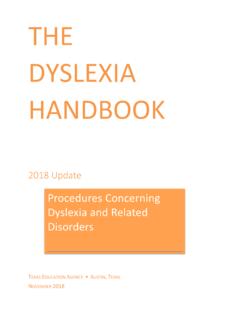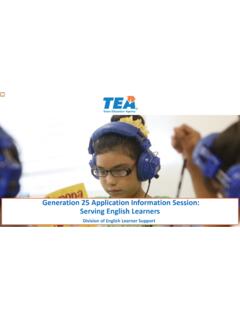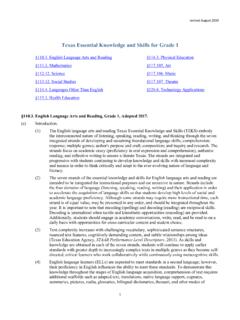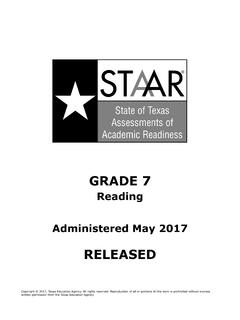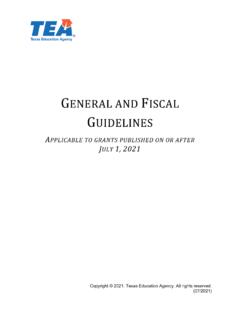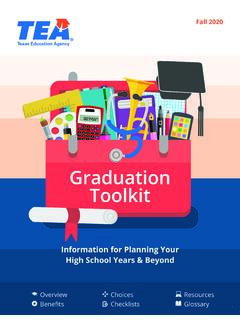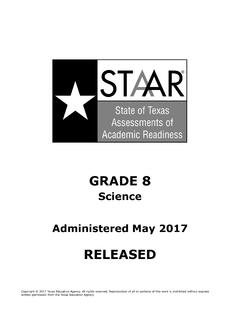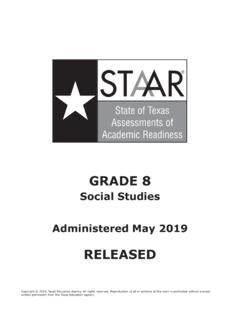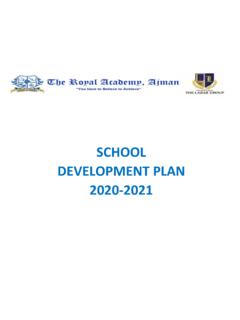Transcription of Early Childhood Outcomes and Prekindergarten Guidelines ...
1 Early Childhood Outcomes and Prekindergarten Guidelines Alignment Updated with the Revised 2015 Texas Pre-K Guidelines This page has been left blank intentionally. Early Childhood Outcomes and Prekindergarten Guidelines Alignment Copyright notice Original copyright 2011 Education Service Center Region 13 and the Texas Education Agency. Updated 2017, Education Service Center Region 13. Permission for use: This alignment document was developed at public expense to benefit Texas public school districts, state-approved charter schools, Texas regional education service centers and other Texas non-profit Early Childhood entities. Residents of and non-profit entities operating within the State of Texas may freely copy, distribute, create derivative products based on, and publicly display and perform this alignment document ( use the document ) for the intended beneficiaries.
2 This document may be used as a resource for educational purposes by educational grantees of federal funds in other states, with the stipulation that the material be properly attributed to the copyright owners. Original Early Childhood Outcomes from: Texas Education Agency | IDEA Support Education Service Center Region 13. The Early Childhood Outcomes Center William B. Travis Building Special Education CB 8040 1701 N. Congress Avenue 5701 Springdale Road UNC Chapel Hill Austin, TX 78701 Austin, TX 78723. Chapel Hill, NC 27599-8040. 1. Table of Contents Introduction Welcome to the Early Childhood Outcomes and Texas Prekindergarten Guidelines Alignment 3. Understanding the Three Early Childhood Outcomes (ECO) 4. Guiding Principles 5. Utilizing the Early Childhood Outcomes and Texas Prekindergarten Guidelines Alignment Supporting Instruction for Children with Unique Needs 6.
3 Writing Developmentally Appropriate Goals and Objectives 8. Skill Domains I. Social and Emotional Development 9. II. Language and Communication 28. III. Emerging Literacy: Reading 57. IV. Emerging Literacy: Writing 79. V. Mathematics 98. VI. Science 116. VII. Social Studies 124. VIII. Fine Arts 136. IX. Physical Development 143. X. Technology 150. References 157. Organization of Early Childhood Outcomes and Prekindergarten Guidelines Alignment This document addresses the ten domains of the Prekindergarten Guidelines , retaining the same order and color coding. Some of the original text from the Prekindergarten Guidelines has been edited to emphasize the importance and application of these Guidelines to a child with a disability who may function at the level of a younger child. Within the document, the gender of the child and teacher are referred to using his/her or he/she interchangeably.
4 *Science, Fine Arts, and Technology do not include the developmental continuum column. 2. Introduction Welcome to the Early Childhood Outcomes and Texas Prekindergarten Guidelines Alignment In 2005, the Office of Special Education Programs (OSEP) began to compile data from State Early Intervention and Preschool Special Education programs to report on child and family Outcomes . This information about Early Childhood Outcomes (ECO) is required for all children in preschool programs for children with disabilities (ages three through five), and in Texas is reported on the Child outcome Summary Form (COS Form). This information is collected throughout Texas and in other states to measure the effectiveness of intervention for this age group. In Texas, the summary of data is reported to the Texas Education Agency (TEA) by each Local Education Agency (LEA) as part of the State Performance Plan (SPP 7).
5 For child Outcomes , states are required to report on the percentage of preschool children with Individualized Education Programs (IEPs) who demonstrate improved: 1. positive social-emotional skills (including social relationships);. 2. acquisition and use of knowledge and skills (including Early language/communication [and Early literacy]); and 3. use of appropriate behaviors to meet their needs. The Texas Prekindergarten Guidelines offers detailed descriptions of expected behaviors across multiple skill domains that should be observed in four- to five-year-old children by the end of their Prekindergarten experience. Statement of Purpose The purpose of this document is to align each Prekindergarten guideline to one or more of the three Early Childhood Outcomes , and provide educators and families with discussion prompts to explain how each outcome relates to the guideline.
6 The document also provides modifications and adaptations for children with special needs and extends to include a developmental continuum for teachers to use in developing appropriate goals for children who are developmentally functioning below four-year-old expectations, based on the Guidelines . Additionally, a separate column is included that lists foundational skills that will lead to expected three-year-old and four-year-old skills. This will provide a direct link to the Prekindergarten Guidelines and a starting point for the students who are the farthest away from age-appropriate skill levels when they enter Early Childhood Special Education Programs. The connection of the foundational skills to the Prekindergarten Guidelines will help educators design developmentally appropriate, individualized goals for their youngest learners, including students with disabilities, students learning English as a second language, and any child who may be at risk educationally.
7 Some children, regardless of age, will be at the beginning of the learning continuum (foundational skills), while others will be further along. Children with disabilities may need accommodations and modifications in order to benefit from the Guidelines . Early Childhood Outcomes materials adapted from the Early Childhood outcome Center, online at (Funding provided through the Office of Special Education Programs, US Department of Education [OSEP]). The Texas Prekindergarten Guidelines are a joint effort of TEA and the University of Texas System (copyright 2015). 3. Understanding the Early Childhood Outcomes The following three Early Childhood Outcomes are considered essential to children becoming active and successful participants in a variety of settings. All states are required to report data to the Department of Education's, Office of Special Education Programs regarding these child Outcomes : 1 2 3.
8 Positive social emotional skills (including Acquisition and use of knowledge and skills Use of appropriate behaviors to meet social relationships). (including Early language/ communication their needs. Making new friends and learning to get along with and Early literacy). As children develop, they become increasingly others is an important accomplishment of the Early Over the Early Childhood period, children display more able to act upon their world. With the help of Childhood years. Children develop a sense of who tremendous changes in what they know and supportive adults, young children learn to address they are by having rich and rewarding experiences can do. The knowledge and skills acquired in the their needs in ever-more sophisticated ways and interacting with adults and peers. They also learn Early Childhood years, such as those related to with increasing independence.
9 They integrate that different rules and norms apply to different communication, Early literacy, and Early numeracy, their developing skills, such as fine motor skills everyday settings and that they need to adjust provide the foundation for success in kindergarten and increasingly complex communication skills, their behavior accordingly. This outcome involves and the Early school years. This outcome involves to achieve goals that are of value to them. This relating to adults, relating to other children, and for activities such as thinking, reasoning, remembering, outcome involves behaviors like taking care of basic older children following rules related to groups or problem solving, number concepts, counting, and needs, getting from place to place, using tools (such interacting with others. The outcome encompasses understanding the physical and social worlds.)
10 It as forks, toothbrushes, and crayons), and, in older concepts and behaviors such as attachment/ also addresses a variety of skills related to language children, contributing to their own health, safety, and separation/autonomy, expressing emotions and and literacy including vocabulary, phonological well-being. It also includes integrating motor skills feelings, learning rules and expectations in social awareness, and letter recognition. to complete tasks; taking care of oneself in areas situations, and social interactions and social play. like dressing, feeding, grooming, and toileting; and acting on the world in socially appropriate ways to get what one wants. The Early Childhood Outcomes Center, November 2009. 4. Principles that Guide this Alignment Every child is unique and capable of learning. All children can learn and will benefit from high expectations that are: age respectful individualized interest-based culturally sensitive linguistically appropriate A student's educational progress rests on the quality of instruction provided by the teacher.
